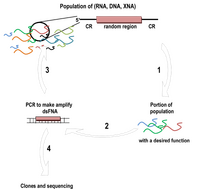CH391L/S13/In vitro Selection of FNAs
Introduction
Functional Nucleic Acids (FNAs), as described by Dr. S.K. Silverman, are DNA and RNA aptamers that bind targets, or they are deoxyribozymes (single stranded DNA) and ribozymes (RNA) that have catalytic activity.[1] Aptamers, Ribozymes, and Deoxyribozymes are grouped into three main categories that are further classified into either natural or artificial depending on their origin. The exception being Deoxyribozymes as they have yet to be discovered in a living organism. Although the first ribozyme was discovered only in the 1980s, the search for new and better FNAs continues. This has led the development of new methodologies, such as the SELEX [2, 3] or In vitro selection, as we strive to expand their potential both as tools for exploring biology and solving real world problem solving.

Functional Nucleic Acids
Ribozymes
Most natural ribozymes, RNA catalysts, catalyze mostly some type of scission or ligation that involves some type of phosphodiester chemistry. In vitro selected ribozymes are displaying a versatile level of sophistication of the sort required for cellular metabolism.[9]
Examples of Natural Ribozymes
Deoxyribozymes

An interesting discovery was made in the early 1990s, when for the first time DNA was shown that, besides being a genetic information storage molecule, it could also be both an enzyme and an aptamer. In the figure below you can observe 8-17, an RNA cleaving DNA enzyme. This molecule with 10-23 were the first to be described and tested in vivo as potential new therapies for cleaving the expressed mRNA of a virus. [7] Although proteins offer a larger diversity chemistries, depending on amino acids vs. both kinds of nucleic acids, as the latter ones depend on a limited array of nucleotides. Until know around a dozen distinct types of reactions. These include the following activities such as self-phosphorylation, RNA labeling, depurination,etc [10]
Aptamers and Riboswitches
The word aptamer from the latin aptus and translates as the past participle of "to fit" were originally identified by employing the protocol SELEX [2, 3]. Therefore, the word Aptamer describes their basic function as RNA or single stranded DNA (ssDNA)that can bind a ligand by assuming an specific structure [11, 12]. Yet, it would take several years until the discovery of the first in vivo aptamer or riboswitch [13].
In vitro Selection of Functional Nucleic Acids

A SELEX or In vitro Selection Experiment , describes the basic method for performing a SELEX or uses single stranded nucleic acids that are chemically synthesized,with a constant region (CR) and a fixed random region of length n. The random region of length n has only 4 nucleotides available, so the size of sequence space tested increases as 4n. Since only 1014 molecules can be sample in any given experiment, a point where the sequence space is larger, we can only sample sparse regions of this sequence space. Case in point, for a pool where "n" = 60 the actual sequence space is 1036 molecules. Important considerations of an In vitro selection:
- Random Region Length: Shorter Nx regions allow greater coverage.
- Potential Structural Complexity: Longer Nx regions allow greater complexity of secondary and tertiary structure.
- Potential to misfold: Longer Nx regions tend to misfold much more than short Nx regions. Therefore it's important to asses the emergent catalytic activities vs. random region length.
[1]
The In vitro selection experiment
The first step is subjecting the population of single stranded nucleic acids or "pools" to specific selective condition in which function is possible. Then a (2) diverse subset of the population will perform the desired function and will be then (3) PCR (Polymerase Chain Reaction) amplified to regenerate the single stranded nucleic acids making use of CR introduced previously. The previous step is necessary for the selection's continuation into the next selection round, while at the same time a sample is obtained and can be sequenced. The reason why several rounds of selection are required is that we want to enrich the portion of the population with our desired function from the background noise, cheater sequences (non-function), that exist at the beginning of the experiment.
Examples of Functional Nucleic Acids
DNA-catalyzed DNA cleavage
DNA cleavage by a deoxyribozyme uses to main mechanisms, either they cleaved their DNA substrate by hydrolysis or via deglycosylation, a carbohydrate (sugar) is detached from the DNA subtrate which is the followed by two β-eliminations. Examples of such Deoxyribozyme include 8VA4 or 8VA10 respectively[1].
Deoxyribozyme-Catalyzed RNA labeling
Deoxyribozyme-catalyze labeling (DECAL), by 10DM24 deozyribozyme, "approach for site-specific internal RNA modification" that is attached to a labelled target RNA.[14] In a similar manner 7TQ20, can form a nucleopetide linkage to 5' pppRNA, provided an anchored small tripeptide is provided, in this case Cys-Tyr-Ala. FOr this deoxyribozyme to form the nucleopeptide linkage the Tyr -OH plays an important role[1].
The Flexizyme
One of the most interesting FNAs now available to new tool are flexizymes that perform a “de novo” self-aminoacylating ribozyme. The ribozyme was generated in an “in vitro selection” of a tRNA with a N70 region, that replaces the aromatic moeity of a tRNA, and that can add both natural and non-natural amino acids by reprogramming genetic code. According to the authors the “Flexizyme system [has] virtually no limitation in the use of amino acid donors and tRNAs. It is also gives “flexibility in the choice of acids” [15].
iGEM Link
TheTPP ribozyme biobrick made by the Pekin 2011 team combines both an aptamer and a ribozyme for regulatory purposes of making a genetic rheostat. A genetic rheostat would be a device that modulates or regulates precisely the expression in response to a wide range of ligand concentration. Furthermore, it would only respond to an orthogonal ligand to the host cell.
References
<biblio>
- Cech1982 pmid=6297745
- Altman1983 pmid=6197186
- Breaker2002 pmid=12022469
- Silverman2009 isbn=978-0-387-73711-9
- Ellington1990 pmid=1697402
- Gold1990 pmid=2200121
- Winkler2002 pmid=12410317
- GoTo2006 pmid=17150804
- Breaker2000 pmid=11187837
- Cech2002 pmid=12110898
- Silverman2012 pmid=23088677
- Silverman2007 pmid=17394278
<\biblio>